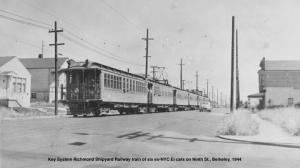Opened (?) Extinction 30 September 1945 | Closed September 30, 1945 | |
 | ||
Track gauge 4 ft 8 ⁄2 in (1,435 mm) | ||
Richmond shipyard railway 563 rollout
The Shipyard Railway was an electric railroad line, rapidly constructed during World War II to transport workers to and from the Kaiser Shipyards located in the city of Richmond, California.
Contents
The Shipyard Railway was funded by the United States Maritime Commission and was built and operated by the Key System, a local transit company in the East Bay of the San Francisco Bay Area. The Key System also provided commuter rail service between San Francisco and the East Bay over the Bay Bridge.
The Shipyard Railway ran from a specially constructed depot at 40th Street and San Pablo Avenue in Emeryville, up San Pablo Avenue northward (along the Key System's No. 2 San Pablo Avenue line streetcar tracks) to Grayson Street in Berkeley then two blocks west to Ninth Street, then a far stretch north along Ninth (along the recently abandoned Interurban Electric Railway's No. 5 Ninth Street line's tracks), across a bridge over Codornices Creek, then diagonally northwest across Albany Village, a federal housing project for war workers, then up and over a specially constructed trestle above the main line of the Southern Pacific Railroad and the Eastshore Highway, thence continuing northwest along the bayshore in Richmond, and terminating in a loop line serving the four massive shipyards of Kaiser.
The line was built from scrap and available materials, as the war made regular construction materials unavailable. The rails were reused from abandoned streetcar lines. The railroad across the Bay Bridge no longer needed overhead wire, as the Key bridge units operated over the bridge using a third rail and both the Southern Pacific (IER) and Sacramento Northern Railway had discontinued service. For the trestle over the Southern Pacific Railroad, bridge beams were fashioned out of used Southern Pacific turntables, and timbers were reused from those ferry moles no longer in use due to the Bay Bridge.
The United States Maritime Commission searched and found obsolete New York City "El" elevated cars awaiting scrap. These wood-bodied cars had been built in 1890 for the New York City IRT Second Avenue Line, initially pulled by steam locomotives and equipped with traction motors and controls prior to 1900. The cars were configured for high-level platforms and third rail, and were roughly adapted to street operation from overhead wire. The Key System did not possess enough pantographs for every car, so they placed one on each married pair of cars. This too proved challenging, as the old wood roofs could not support the weight of a pantograph. Some high level platforms were built, and the Key System's newest cars, "Bridge Units", were operated on the line while a limited number of New York cars were equipped with makeshift steps to street level. These cars became the symbol of the Shipyard Railway.
At the end of World War II, the Shipyard Railway was offered to the Key System, but they declined, viewing the line as unprofitable. Service ended on September 30, 1945, and the line was quickly dismantled.
Shipyard cars #561 and #563, a married pair, are preserved at the Western Railway Museum. #561 is restored and is believed to be the oldest operational electric car in the United States. #563 is under restoration.
